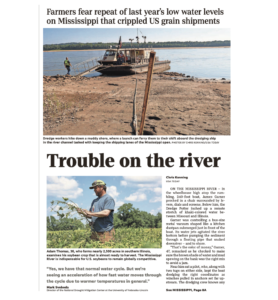Congress has quickly engaged in putting together potential aid packages for farmers that would more than double the Trump administration's $12 billion under the Farmer Bridge Assistance (FBA) Program.
USA Today: “Trouble on the River,” Mississippi Water Levels a Concern Again This Fall
Chris Kenning reported on the front page of today’s USA Today that, “In the wheelhouse high atop the rumbling, 240-foot boat, James Garner perched in a chair surrounded by levers, dials and screens. Below him, the Dredge Potter inched up a remote stretch of khaki-colored water between Missouri and Illinois.
“Garner was controlling a bus-sized metal vacuum shaped like a kitchen dustpan submerged just in front of the boat. Its water jets agitated the river bottom before pumping the sediment through a floating pipe that snaked downriver – and to shore.”

Today’s article explained that, “For 92 years, the U.S. Army Corps of Engineers’ Depression-era dredge has helped maintain a 9-foot-deep Mississippi channel for tow barges that haul more than 500 million tons of cargo a year on America’s most important maritime highway.
That work has taken on heightened urgency this year, as drought and heat reduce river levels and rekindle worries about a second year of costly shipping delays.
“Last fall, drought led to about 40 days of critically low water in parts of the Mississippi that hadn’t seen it in years – grounding barges, stalling traffic, blocking river ports at the height of harvest season and causing an estimated $20 billion in losses, according to AccuWeather.
“As this year’s harvest approaches, the river is again on the decline.”
Kenning pointed out that, “It’s still not known whether the river will drop as low as last year.
Mississippi River at Vicksburg pic.twitter.com/eJgMJx4Mgc
— FarmPolicy (@FarmPolicy) September 13, 2023
“But Mississippi water levels have been falling since June.
Mississippi River at Memphis pic.twitter.com/hn3oYiK6EA
— FarmPolicy (@FarmPolicy) September 13, 2023
“The Ohio River – where it meets the Mississippi at Cairo, Illinois, and serves as its largest tributary – dropped almost 10 feet in the last two weeks of August. Levels are predicted to fall farther in the coming weeks.”
Ohio River at Cairo pic.twitter.com/XqYSvwCWZG
— FarmPolicy (@FarmPolicy) September 13, 2023
The USA Today article added that, “With 61% of the Midwest classified as abnormally dry or in drought as of late August, most of the Mississippi is expected to face low water in September that will most likely affect industry and navigation, according to the National Integrated Drought Information System.
30- Day Departure From Normal Precipitation pic.twitter.com/U1eMNkSFsL
— FarmPolicy (@FarmPolicy) September 13, 2023
“That is, unless enough rain falls in the right places and amounts.”
“That’s worrying farmers who ship grains such as soybeans on the river to New Orleans and, from there, around the globe – relying on lower costs that help keep it competitive for the global export market. They fear another year of backups and spiking costs that eat into profits,” Kenning said.
Recall that earlier this month, Bloomberg writer Tarso Veloso Ribeiro reported that, “The cost to transport America’s harvest from the Midwest to the rest of the world is soaring as shrinking water levels on the Mississippi River drive up barge freight rates — and the forecast for below-than-average rainfall offers no relief.”
In other news, Reuters writer Pavel Polityuk reported yesterday that, “Ukraine, which has had to find different ways to export its grain since Russia quit the U.N.-brokered Black Sea grain export deal in mid-July, is stepping up road and rail shipments, brokers said on Wednesday.
“Spike Brokers said 188,000 metric tons of agricultural goods were exported by lorries in the Sept. 1-11 period, compared 169,000 tons in the corresponding period in August. It had shipped 146,000 tons in the corresponding period in July.”
The article added that, “Brokers said the grain exports by rail via the Ukrainian-Polish border had also increased by 14% over the past week.”
Another attack by Russian/Iranian Shaheds on port infrastructure. Last night, Izmail and Reni were attacked with the aim of destroying an alternative route for agricultural exports.
— Oleksandr Kubrakov (@OlKubrakov) September 13, 2023
Due to the attacks, the Danube ports have already reduced their export potential by almost 0.5M… pic.twitter.com/Rk5TVQMbX8
Meanwhile, Financial Times writer John Paul Rathbone reported earlier this week that, “For the past two months, Russia has launched waves of drone attacks on Ukraine’s Danube ports. Their aim has been to cripple Ukraine’s economic infrastructure and the export routes set up to break Moscow’s naval blockade of the Black Sea, Kyiv and its western allies say.
“Ukraine, which produces half the world’s sunflower oil exports and 10 per cent of its wheat, has exported about 35mn tonnes of grain via the Danube over the past 12 months. Alongside rail freight through Europe, this has provided vital economic support for the country’s war effort against the Russian invaders.
“But how long Ukrainian companies can absorb the extra cost of these alternative routes has become a pressing issue — especially after Russian president Vladimir Putin on July 17 suspended a UN-brokered deal that had allowed the safe export of 33mn tonnes of Ukrainian grain via the Black Sea.”
The FT article noted that, “The rerouting of Ukrainian exports via the Danube has been a logistical task of Herculean proportions.
“So many trucks carry grain to Izmail and the nearby Danube port of Reni that queues can back up 35km. To preserve road surfaces during the summer, they can only travel at night or when day temperatures are less than 28C. The grain is then loaded into barges, sailed via inland waterways to Romania’s Black Sea port of Constanta, where the cargo is loaded on to larger seaborne tankers.
“There are also significant costs involved. Viktor Berestenko, president of Ukraine’s association of international freight forwarders, estimates that to export a tonne of grain to Egypt via the Danube costs about $116 per tonne compared with about $69 before Russia’s invasion last year.”





